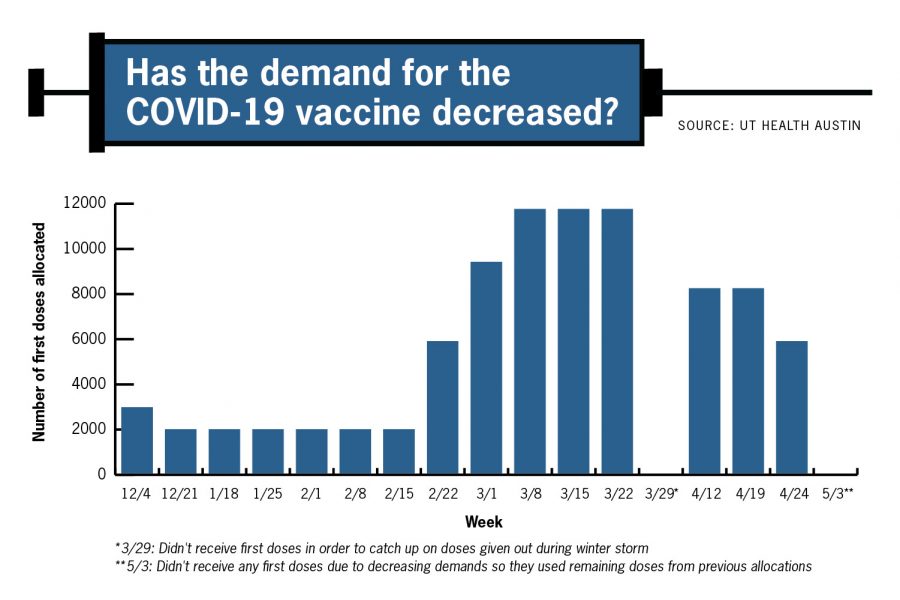COVID-19 vaccine demand drops around U.S., UT
May 7, 2021
The University, along with the rest of the country, is seeing a decrease in demand for the COVID-19 vaccine, with UT vaccine allocations dropping by more than half since March 22, according to state health data.
Lisa Jackson, the executive clinical director for UT Health Austin, said within the last week, the number of vaccine doses they are receiving is greater than the number of shots they are giving out every week, so they have not used all that they have been allocated.
According to the Texas Department of State Health Services vaccine allocation data, during the week of March 22, UT Health Austin received 11,700 Pfizer first doses. On the week of April 19, they received 8,190, and on the week of April 26, the number of doses went down to 5,850.
“This is being replicated all over the country … there could be a lot of potential reasons for that, but we don’t have people making appointments,” Jackson said.
Julie Swann, the department head of industrial and systems engineering at North Carolina State University, has been working on pandemic models, systems and supply chains since the 2009 H1N1 vaccination campaign. She said with the decreasing demand for vaccines, achieving herd immunity is going to be difficult for the United States.
“A lot of the projections on how long it would take us to return to normal were based on demand and vaccination pace continuing,” Swann said. “We’re not going to be vaccinating at the same pace this month as we were last month.”
Susan Hochman, associate director for assessment, communications, and health information technology at University Health Services, said in an email that UT Health Austin didn’t receive first doses because of the decrease in demand, so they used remaining doses from previous allocations. According to the Centers for Disease Control and Prevention, doses that are kept in the freezer are safe to use for two weeks.
Despite decreasing demands, Jackson said they have never thrown away any vaccines. She said all the extra vaccines that weren’t used are given to VaxNow, a School of Nursing vaccination program that takes the leftover vaccines and gives them to anyone who is unable to access them.
“We know ahead of time how many people are on the schedule, but we can’t predict how many no-shows we’ll have,” Jackson said. “Now we’ve gotten it down pretty good, and usually, it’s in the single digits if we have any leftovers at the end of the day, so it’s generally a small number.”
Jackson said UT Health Austin promoted walk-up appointments as a way to increase the number of people getting vaccinated, but that has not significantly increased demand.
“The first couple of days, we were having 50 to 100 (walk-ups), but now, we’re probably less than 50 a day, so very few,” Jackson said. “It’s all just kind of a guessing game.”
Jackson said UT Health Austin’s plan for the summer is to move vaccine administration from Gregory Gym to the Health Transformation Building, located off of Trinity and 17th street, to accommodate for the decreasing demand for the vaccine. She said they will continue to do both walk-ins and appointments.
Jackson said she hopes the U.S. Food and Drug Administration will approve the use of the vaccine for people above 12 years old within the next week, which she expects will increase the demand.











